|
Teaching Your Rat Tricks
 Teaching your Fancy Rat tricks is fun and really pretty easy to do. Rats do not train like a dog would but they are a lot like training a cat. It may take longer to train your rat to jump through a hoop then it would to train a dog the same trick, but have fun, take your time and bring treats. Be fair and just to your animals while training and have fun. Teach your rat one rat trick at a time. After the rat understands the first trick you can then begin to train another trick. Teaching your Fancy Rat tricks is fun and really pretty easy to do. Rats do not train like a dog would but they are a lot like training a cat. It may take longer to train your rat to jump through a hoop then it would to train a dog the same trick, but have fun, take your time and bring treats. Be fair and just to your animals while training and have fun. Teach your rat one rat trick at a time. After the rat understands the first trick you can then begin to train another trick.
Repetition is the key. Try to show the rattie the same way each time. Try to hold you hands and your face the same each time you teach the same trick. You may have to show the rat 3 times or 10 times or 20 times, but when the light bulb goes off in the ratties head, it will remember the task and repeat it each time you ask.
Don't loose your patience, just relax and enjoy the fun time spent with your pet. If you have two ratties you are training at the same time (one at a time but teaching the same LOL) Let the other one watch, you may be surprised what they learn from watching. By the same token, if you have a rat that knows a trick let the new comer to trick training watch the already trained rat perform.
Train at your own risk. We are giving ideas and telling you what has worked for us. You and you alone are responsible for the training you do with your own animals. Put safety above all.
 TEACHING YOUR RAT TO RIDE ON YOUR SHOULDER 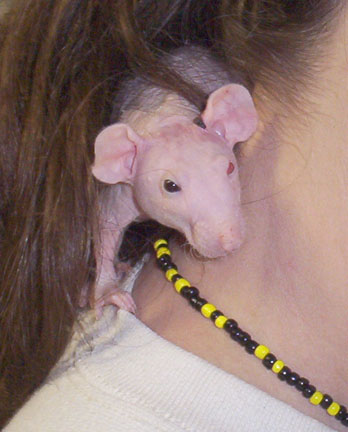 Some rats learn this easily, some need a bit more training. As I have said before, rats are individuals. My husband and I got two baby rat sisters. We took them out of their cage each time together, he worked with the same one each time and I worked with the same one each time for the same amount of time. My rat, Rita, would sit on my shoulder and pretty much stayed there from the beginning. When she would start to come down my arm or front I would say "no" and put her back up on my shoulder, always my left, I am right handed. In just a few sections she learned to stay on my shoulder even when I walked around until I took her down (my husband "spotted me" when I started walking so that if she jumped backwards he could grab her) . My husband's rat, Ace, would only stay on his shoulder for a moment, then off down his arm, or front. Now, here is the difference, I have long hair, down my back. Rita likes to sit under my hair looking out from under it. If I have it pulled back into a pony tail Rita will move under my pony tail more to the back of my neck rather then sit on my actual shoulder. I do know that rats are different, some take right to shoulder riding others don't.....but I often wonder if hair length of the "ride" makes a difference. Some rats learn this easily, some need a bit more training. As I have said before, rats are individuals. My husband and I got two baby rat sisters. We took them out of their cage each time together, he worked with the same one each time and I worked with the same one each time for the same amount of time. My rat, Rita, would sit on my shoulder and pretty much stayed there from the beginning. When she would start to come down my arm or front I would say "no" and put her back up on my shoulder, always my left, I am right handed. In just a few sections she learned to stay on my shoulder even when I walked around until I took her down (my husband "spotted me" when I started walking so that if she jumped backwards he could grab her) . My husband's rat, Ace, would only stay on his shoulder for a moment, then off down his arm, or front. Now, here is the difference, I have long hair, down my back. Rita likes to sit under my hair looking out from under it. If I have it pulled back into a pony tail Rita will move under my pony tail more to the back of my neck rather then sit on my actual shoulder. I do know that rats are different, some take right to shoulder riding others don't.....but I often wonder if hair length of the "ride" makes a difference.
When training your rat to ride on your shoulder you need to work in several sections like any other trick. Start out slow and build the time spent on the shoulder over several section. Don't let the rat come down when it wants to, but you should know when it is done with this "game". In other words, end the shoulder sitting BEFORE the rat leaves your shoulder. This way the rat will trust that you will get it down. If you let the rat just get down when it wants...it always will. Any time, any place, when the rat decides to get down it will.....this is not safe. Put the rat on your shoulder and kind of support it by leaving your hand near by so that if the rat comes down you can gently block it or put it back where it was. Talk to the rat and use it's name while it is on your shoulder. DON'T walk around with the rat until the rat is comfortable over several sections on your shoulder and remains on your shoulders until you take it down. Have someone walk behind you quietly for the first few times. DON'T put a rat on your shoulder with your family mouser (cat) in the room. DON'T walk outside with the rat on your shoulder. DON'T take your rat down to the local bar riding on your shoulder....think about how ugly this could get....think Law Suit  . Shoulder riding is a trick made for home, having fun with your rat with your hands free. . Shoulder riding is a trick made for home, having fun with your rat with your hands free.
This is a photo of Spirit. He was adorable. His personality was as big as his looks. My husband always called Spirit a "triple threat". Spirit was an Odd Eyed Hairless Dumbo Rat.
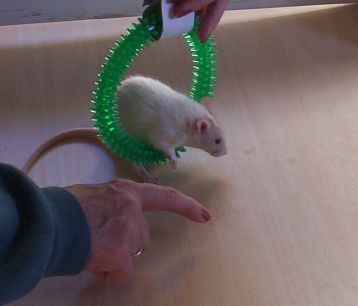
 TEACHING YOUR SMALL ANIMAL TO JUMP THROUGH A HOOP Well, first you need a small hoop. The animals that I will usually work with are a Guinea Pig and Rats, so my hoop needs to be about 6" -10" in diameter. Remember the old Jarts game? Now one of those hoops would be perfect, if too large you can take them apart and trim them down. Use a hoop according to the size of your pet. Other ideas would be an embroidery hoop, the outer rim of an ice cream tub top, a bucket cut apart and covered with fabric, a (thin) wreath, a tennis racket minus the string.....there are many possibilities, just make sure that there are no sharp edges and if you will have an audience cover the hoop to make it attractive with pretty duct tape (it now comes in many colors) or fabric. I bought an 8" wooden embroidery hoop at a Thrift Shop for .10. Watch Garages Sales too.
To teach Jumping Through a Hoop, hold the hoop in front of the animal, who calm and is in a safe place, you are holding the hoop so that it touches the ground or bottom of the cage. Call the animal's name while holding a treat in your other hand on the far side of the hoop to entice the animal to step forward to receive the treat. Here is where you might need three hands  . If the animal does not come forward, or if it moves away from the hoop, give the animal a cupped hand nudge, or easy push, thru the hoop....MAKE A BIG DEAL.....not screaming of course, this would scare the animal. Treat the animal, this is where clicker trainers would click the clicker. Now, repeat this step over and over until the animal comes thru the hoop on it's own and is happy doing it. . If the animal does not come forward, or if it moves away from the hoop, give the animal a cupped hand nudge, or easy push, thru the hoop....MAKE A BIG DEAL.....not screaming of course, this would scare the animal. Treat the animal, this is where clicker trainers would click the clicker. Now, repeat this step over and over until the animal comes thru the hoop on it's own and is happy doing it.
The rattie in the picture is Nineveh and is at the time of the photo approx. 18 weeks old. This photo was from the first or second time she started using the hoop. Yes, I am very proud of her.
After the animal is comfortable coming thru the hoop on it's own, lift the hoop up just a bit. Each time the animal has completed the task, treat, click or whatever you do to let the animal know it has done what it was asked to do and it has pleased you. Now, you can start raising the hoop more and more (keeping it within reason per the species) but remember Guinea Pigs are only going to (or should) jump the hoop at about an inch. Now a Rat could jump the hoop at 6", Hamster, well, let's just say if you get your hamster to do this be happy with the hoop touching the ground...you have done well.
Please let us know how your training is going with your animals and where you found your props. We can all share and have better animal relationships because of it.
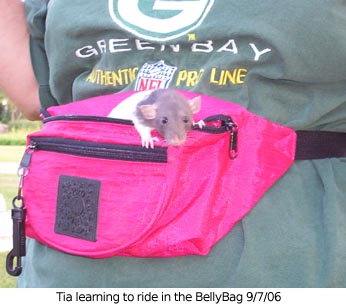
TEACHING YOUR RAT TO RIDE IN A BELLY BAG
First you are going to need a belly bag for your rat. You will not want to use the same one that your "purse items" are in because there is a good chance that the rat will pee and/or poop in their bag or get nosy and chew your things. If you use a "used" belly bag make sure that there are no holes in it. Also make sure that you wash and hang to dry a used belly bag so that it is fresh smelling for the rat. If there was candy or gum in the bag and the bag smelled like candy or gum, the rat may chew on the used bag. The trick to this training is to start your rat off in the belly bag while you are watching television or at the computer and can pay attention to what the rat is doing. Put a small treat in the bag and add the rat...DO NOT close the zipper all the way. Rat tails often get caught in zippers and your rat will feel more secure if they are not "shut in". Leave the rat in the belly bag for longer and longer each section you work with your rat on this trick. Be sure to talk to and pet the rat while it is in the bag. After your rat is comfortable in the bag while you are sitting, start walking around the house for short walks, then later in other sections lengthen your walks around the house. It won't be long and you will be sneaking your pet rat out in public with you as you grin because no one knows the rat is even there. Just be sure you always are aware of what the rat is doing at all times while riding in a belly bag. Check the bag often to see if the rat has been doing any chewing on the bag. If the bag is chewed or torn repair, sew or replace the bag before the next time that your rat will be riding in the belly bag.
The rattie in this photo is Tia. I called her my rattie ambassador. She would go many places with us and sit on my shoulder with a little outfit on. I have long hair, so when people saw her, with her Dumbo Ears and no tail showing, they would ask what "it was". By the time I said a rat she, in all her cuteness had sucked the "Yikes!! She has a rat on her shoulder" right out of them. She converted many people to pet rats.
TEACHING YOUR RATTIE TO COME TO IT'S NAME AND TO RUN SHOULDERS
You can teach your pet rattie to come to you when called. Do this the same way you would teach a dog or cat. Say their name when you feed them, when you pick them up out of their cages, when you move them from person to person, ext. You will be very surprised how fast your rattie will learn it's name.
Once your rat is coming to it's name you can play games with it like, Shoulder to Shoulder.
With your rattie on your shoulder have a friend stand arms lenght from you and set their hand on your shoulder. Have them call the rattie by name and say "Name (rattie's name), Shoulder". Encourage your rattie to run up the other person's arm to their shoulder. Many ratties will just go right away. Some will need to be set on the other person's arm just past their elbow.
Repeat after praising the rattie. Have the rattie come back to you, then after praising the rattie and letting it sit on your for a minute, have the other person to call it back.
If you want to use other cues. Try having the holder say "Go to Name (of the person).
Be sure to praise the rattie for any correct behavior. This trick becomes a fun game for most ratties, does especially love this fun game.
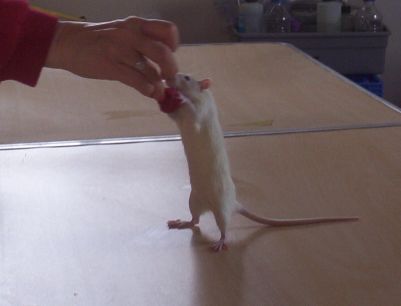
TEACHING YOUR RAT TO SIT/STAND UP
This is a fun little trick that almost anyone can teach a rattie in a very short time. If your rattie takes treats form your had, you are three steps in front of someone who's rattie does not.
If your rattie will take treats from your hand, have tiny treats ready. Set your rattie on a table or desk top with nothing on that area to distract it while you train.
If your rattie does not take treats from you hand try a cat ball with the bell inside of it or a small piece of fabric tied in a ball. You can of course use any item (I would use a very small item) that would get your rattie's attention.
Now, your rattie is on the table top and you are ready to start. Show the rattie the item you have and say "Sit Up" or "Stand" or whatever voice/word cue you are going to use. As the rattie starts to investigate the item, raise the item above the rattie's head. When the rattie goes to follow the item, stop and praise or treat the rattie. Those that use clickers will click here.

As you repeat this trick, raise the item a little more each time. Ratties are pretty smart and some will even stand on the first go round. Make a big ole fuss if they do.
If you are trying to get the rattie to sit, rather then stand, don't raise the item as high and if the rattie comes up, repeat the word "Sit" as you move the item closer to the rattie so that it moves it's butt to the table top.
If you practice this with your rattie a coule of times a day, it will not be long before you can tell your rattie to "Sit Up" and it will, just have that praise ready.
From this trick (after your rattie is doing this one well) you will be able to teach your rattie to walk on it's hind legs.
You do not have to choose between Sit Up and Stand, you can teach both. Just make sure your rattie FULLY understands the first one taught BEFORE beginning to teach the second.
TEACHING YOUR RAT TO ENJOY A BALL

First you will need a very large, rat sized, Run Around Ball with a locking door on it. They come in a variety of colors. The rat sized, or the largest size you can find, will be more expensive and might seem a bit big for your rattie, but trust me, you want the very large ball. You do not want your rattie cramped in a Hamster Size Ball.
Put your rattie inside the ball and set it on the floor. Sit down and leave it alone. Don't stand over it, or push the ball. Just leave the rattie alone in the ball so that it gets used to the whole idea.
ALWAYS double and triple check to make sure that the ball is locked when your rattie is in it. Surely, I do not have to tell you to never ever let the cats or any other animals (or people) bat or push the ball.
If your rat does not start moving the ball around the floor try taking the ball, with the rattie in it, into a dimly lit room. It might take your rattie some time, a few times in the ball I mean, to get used to it.
Don't loose patients. This is all new to your rattie. Most will just sit there the first coulpe of times in the ball. Give it time. Once your rattie understands the idea, it will really enjoy "running around your house".
We have/had three ratties that were a blast in their balls. Two could drive that ball anywhere they wanted to go. Phydeau always went first to take off, she would go first into the bathroom, then into the bedroom all around the bedroom and back....never hitting the doorways, driving it just where she wanted to go. Phi Phi always went straight for the front door.....what was she thinking? She might leave or something? Dutch, even the first time in the ball, will take off right away and head to the bedroom, then the office, off to the bathroom. No doubt, he can drive that ball where he wants to go.
You can also teach your rattie to come to you while in the ball. You will first have to teach your rattie to come to it's name, then let it learn how to manipulate the ball. When it does both, come to it's name and drive the ball, try calling the rattie while it is in the ball.
After removing your rat from the ball, clean out the inside of the ball. I use a wet wipe and let it stand to dry before putting the door back on. That way it is clean and fresh for the next time the ratties what to "run" in them.
 TEACHING YOUR RAT TO ROLL OUT A BARREL 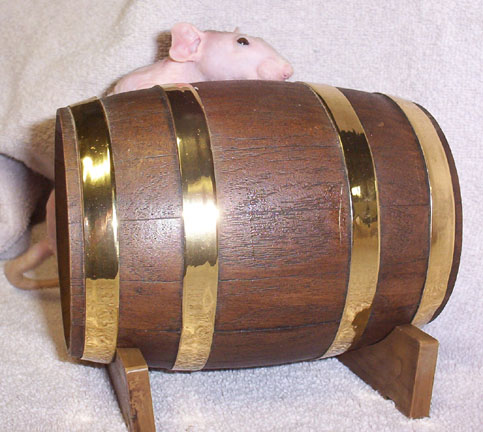 This is another Circus dog or goat trick that a rat can learn if the trainer/teacher is fair and patience. This is an advanced trick. Your rat should be confident doing other tricks and very trusting of you before you start training it to do this particular trick. This is another Circus dog or goat trick that a rat can learn if the trainer/teacher is fair and patience. This is an advanced trick. Your rat should be confident doing other tricks and very trusting of you before you start training it to do this particular trick.
To train this to a rat you will need a small barrel. Do you own a Saint Bernard Dog? Borrow theirs... that is what my rats and I have done. An even better more stable barrel would be a piece of PVC pipe cut to a 6" length that you can decorate with wall paper and/or sandpaper. The sandpaper will give the rat some foot traction as the barrel turns under it. This trick is best taught with a "wall" on either side of the barrel so that the barrel continues to run straight. Use a towel or carpet under the barrel to slow the barrel down a bit.
You will need to have great patience and good humor to teach this trick to your rat. This trick will take several short sections and will take some time to teach the rat to do. Keep in mind when training this trick...it is an advanced trick.
If your rat walks on a leash this will be a great training aid for this trick.
Set everything up to teach this trick, get your treats and then go get your rat. Hold the barrel still as you set the rat gently down on the top of it. Get the rat used to just setting on the barrel. If the rat gets off the barrel, set it back up on the barrel and praise the rat. If you let go of the rat it will get down and leave. Hold the rat lightly on the barrel and verbally praise the rat in a soft voice. For the first few sections do not move the barrel, just have the rat set on the barrel as you hold both the rat and the barrel. After several sections move the barrel under the rat as you are holding the rat lightly and verbally praising the rat. You are done for this section, lift the rat off the barrel.
Remember, when the barrel rolls forward the rat will be walking backwards on the barrel. If the rat takes regular steps forward the barrel will go backwards. You will need to train to not only teach the rat to walk on the barrel, but also backwards.
Slowly train the rat to take small steps on the barrel as it rolls and stop the section. You are going to have several small sections rather then working til the rat "gets it" so that the rat will have good experiences with the barrel and so that the rat will know that the section WILL end. If you let the rat walk or jump off the barrel on it's own it may think that jumping off the barrel IS the trick. Practice this many times in short sections for a few days.
This is a great trick for spectators and for taking pictures. Everyone will want to see your rat do this trick over and over, just don't wear out the rat.
This is again Spirit. Not a great photo of him, but all the same I love it!! Spirit is sorely missed.
GO ROUND
This is a real easy trick to teach your rattie, any rattie can learn this one.
With your rat on your shoulder, hold out your arms in front of your head/face in a circle, clasping your hands together. Tells your rat to "Go round". If you have someone with you have them encourage the rattie to run around the circle of your arms and back to your shoulders. Be sure to give praise by petting and nice words to your rattie after it runs your circle.
Do this two or three times and I bet your rattie learns this trick quick!
DOUBLE GO ROUND
So now your rattie does "Go Round" well. Add a bit more fun to the trick/game. Hold hands with someone else and have the rattie run both arms in a bigger circle.

RAT BOWLING
There are several ways to teach a rat to push a bowling ball towards a set of ten pins.
It is a good idea to have an "alley" set up for your rattie. An alley can be slanted a bit if you like, but does not need to be. A flat surface will work just fine. On your little rattie alley you might want to have side and back boards. That way your bowling pins will not fall everywhere.
Set up your bowling pins, rat sized of course, as you would see them set up for humans in a bowling alley ready for the ball to come down the lane and knock them down. Or set up as you see in this photo.
Now, as I said, there are several ways to teach this to your rattie. Probably the easiest way is to set a treat next to the ball, or wipe a treat on the bowling ball. Show the treat to the rattie and give a command...you could use "push", "play", whatever one or two word cue you would like to give. Be sure to praise your rattie when it touches the ball, even if the ball does not move. If the ball does not move, repeat the cue word and move the rattie close to the ball.
Most ratties will want follow the ball down the alley, you need to train them to stay and let the ball go. Hold the rattie back as the ball rolls.
Come see our funny YouTube Video of Nineveh's first go at Bowling. It was the first time she ever bowling. My husband is a riot with the sound effects he added. The video does not end at the credits.
BARREL RACING
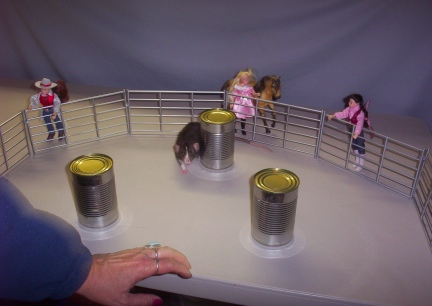
Here is a fun little thing to teach a Fancy Rat and it is not too hard to teach them. Have you ever seen a horse run barrels at break neck speeds? Did you know that Dogs are now racing around barrels in the same patterns as the horses run? so why not rattes?
There is a pattern to follow. The barrels are set up in a cloverleaf, two closest the the start line. [more to come]
BASKET ON A STRING
I am going to try to teach Little Mac that little basket trick. Right now I need to catch up from the holidays. But later next week I am going to find that itty bitty basket I bought. I have seen a goat, monkey, and a rattie do this trick. They pull on the string that dangles over a table or something to bring the basket up to them so they can reach in and get the treat.
How do you teach it?
You tie a string to the end of a tiny basket. You can make one out of cardboard too. I might start with a little bitty jack-o-lantrin that I bought and taught Little Mac to find a treat in. Whatever you use, it needs a handle to tie the string to and needs to be deep enough that the treat does not fall out when the rattie is pulling the string up to it to get to the basket.
You teach the rattie to find a treat in the basket.
Set the rattie on a table or such. And tape the string (about 8 - 12") to the side of the table and let the basket hang. As you are teaching the rattie, at first hold the string so that the basket is just out of reach for the rattie. It might take the rattie a minute to figure it out. As the rattie catches on, lower the string just a little bit at a time. In about a week of daily training (twice or three times daily) your rattie will retrieve the basket all the way by the string alone.
TEACH ANY PET TO OPEN A GIFT
You can teach your pet, any pet, to open a gift in a few easy steps....
Start with a small box. A mouse will need a smaller box then a GP and a GP will need a smaller box then a dog. Use a box that does not have a lid about the same size as your pets food bowl.
Set a treat in the box next to their food dish when feeding. When they take the treat out of the box, say "gooooood" and remove the box. Repeat twice a day for a few days.
In a few days, after the animal has caught on to retrieving the treat from the box, wrap the box, but not the top, with colorful paper. Repeat the idea of leaving this with a treat in it for your pet....most will not even notice the box has changed, or if it did notice it did not care.
Now. Take a piece of newspaper, or tissue paper and wrap it around just the edges of the top of the box. Give a treat in this box, same as before, to the pet. Then next day make the opening a bit smaller, ie, rewrap the top of the box but extend the edges closer to the middle of the box. Give this to your pet as before. Then next day, make the middle smaller and so on. Finally, close the top with paper and watch the animal "open their gift.".

There are so many different types of tricks you can teach a rattie. Once you train or teach your rat to learn, it is easy to train or teach the next trick. If your rattie will come to you for a treat or take a treat from your hand you are ahead of the game.
Many tricks need props, many don't. Be sure to teach your rat some of the tricks that do not require a prop. A trick like "Turning in a Circle", Coming to their name, to "Sit Up", to "Walk" while standing on their back legs, and the list goes on and on.
One of the best things that come from teaching ratties tricks is that you can "promote" your pet to others that are not rat people. Doing tricks, wearing clothes, coming when called makes a rat, in some peoples eyes less of a villain.
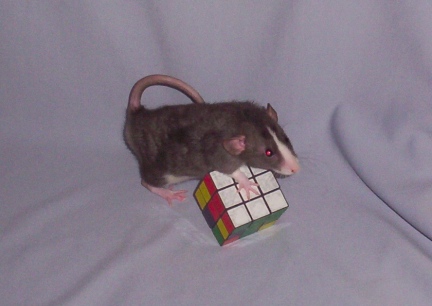
However, when training your animals, any animals, keep your tricks simple. Teach in small steps. Be fair to the animal. And don't expect your animal to have all the answers.
You alone are responsible for training your animals. Any training you do with your animals is your responsibility. We only tell of what has worked for us with our animals. We can not and will not except responsibility for something so far out of our control, people we do not know, training, who knows how, with animals we have never seen.
| 



 In the high plains of South Dakota, USA
In the high plains of South Dakota, USA In the high plains of South Dakota, USA
In the high plains of South Dakota, USA